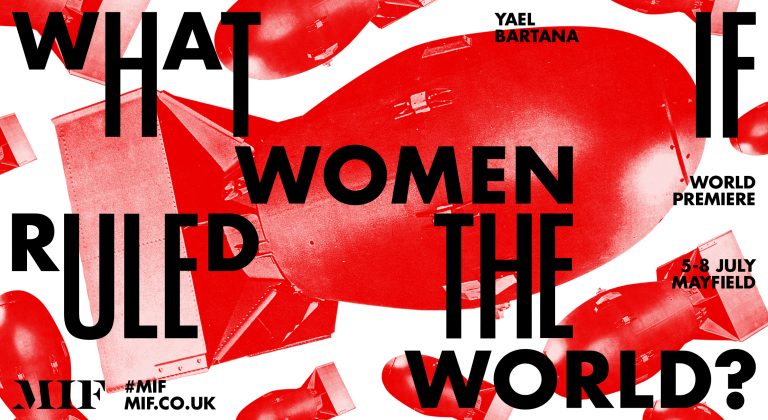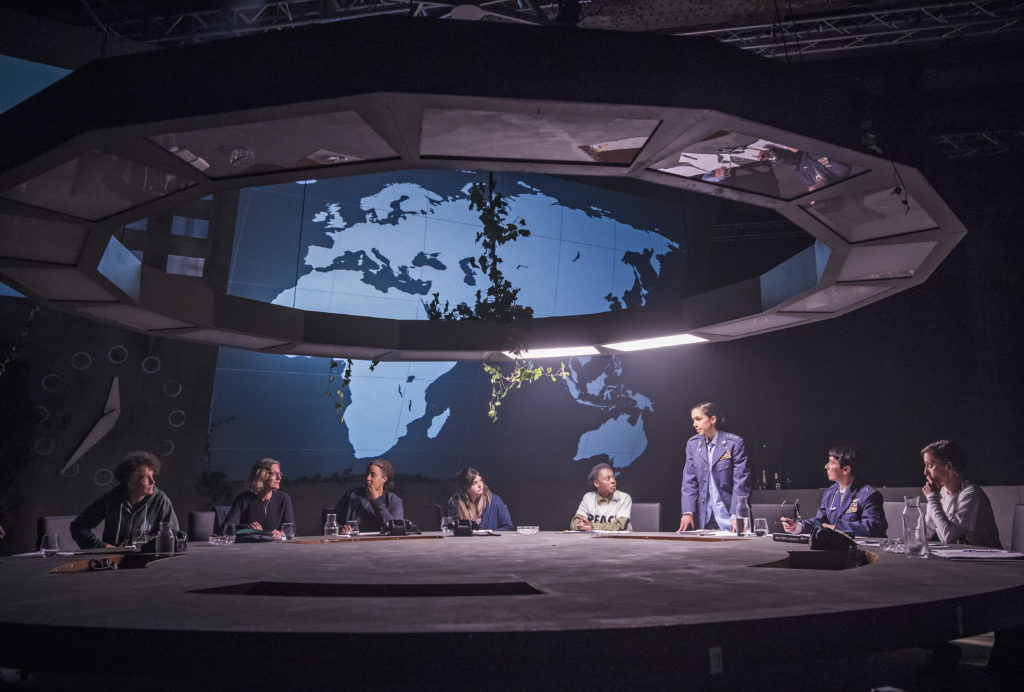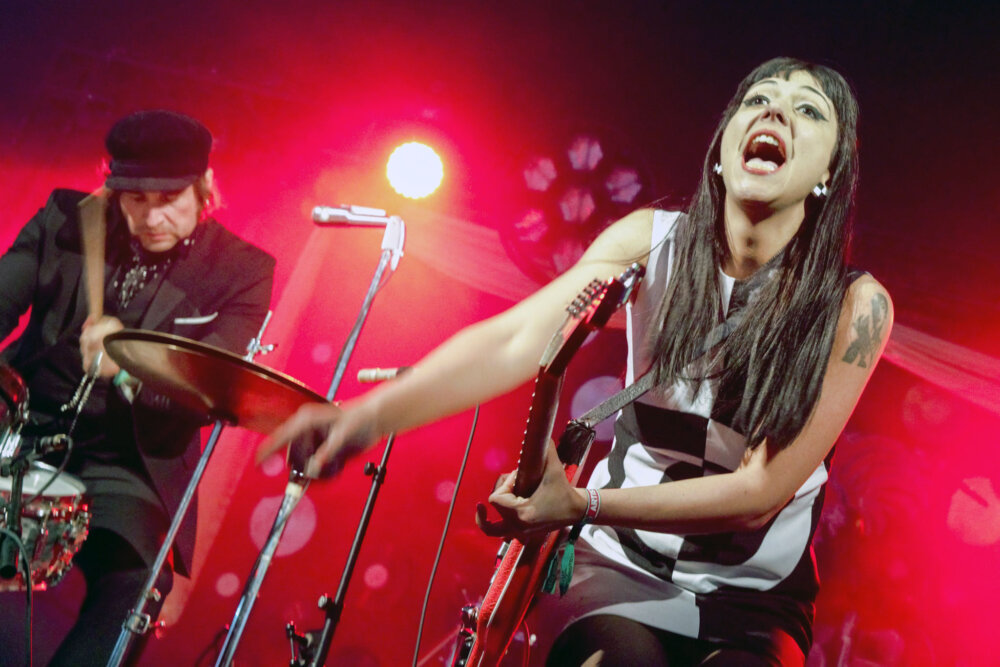Probably not for the first time during MIF17, I found myself wondering “Is this it? This can’t be the right place?” Compared to the previous festival, they seem to have made a point of using as many unused, abandoned, and forgotten venues and buildings around Manchester as they can. Next to what is essentially either a building site or some kind of construction site intent on holding the place in one piece is a makeshift bar. The small and slightly cramped space around it contains a dining/drinking area filled with picnic benches made out of random, ‘found’ objects, a marquee decorated with drab bunting, and cabins painted in a bright purple. The cobbled pavement/floor that has surely seen better days is set in a wide semi-circle. There’s even one of those cheesy, cheap but largely fun seaside ‘photo’ spots – the kind where you stick your face through the allotted space and hope you don’t look too ridiculous – but of course, you do anyway.
Hanging from criss-crossed wires overhead are models and sculptures of people dangling from umbrellas – all in various states of being: composed, calm, and in control, while others are hanging on for dear life, and others still who seem to have basically resigned themselves to a sticky end. The “wheelchair accessible” toilet is both amusing and a little concerning; whoever installed this space clearly hasn’t considered the realities of actually manoeuvring a wheelchair over those cobbles and bricks.
Running late (according to the schedule and showtimes pinned to various surfaces), we’re all eventually ushered into the building that looks like it’s being held together by scaffolding – at least from this side. A little research ahead of arriving told me that this place was a train station once upon a time. Inside it is cold, very dark, and a little wet – there are puddles of water dotted all over the concrete floor. In the arches are spotlights leading the way down to the very back of the building where a stage draped in black faces an area of staggered seats – like a theatre, but less comfortable and much more functional.
A large, round table takes up most of the stage, above it hangs railing draped in greenery that I’m going to assume is meant to give the impression that years – centuries, even – have passed and nature has taken some control over the hard, harsh, and cruel concrete and metal. Atmosphere is provided by severe, bright spotlights and smoke machines. Above the chatter of the audience is an ominous sound of ‘something’ – whether friend or foe in unclear for now. The rest of the audience doesn’t appear to have noticed, though.
Given the set-up of the round table surrounded by chairs, I’m expecting some kind of panel and discussion, etc, around the question of What If Women Ruled The World? The idea based around the end of Stanley Kubrick‘s Dr Strangelove where – in a post-apocalyptic future – the world would be controlled by men, who would repopulate the world, 10 women for every man. Except what if it was the other way around? What if women were the ones in charge? How would the world look then? What I don’t expect (perhaps this is foolishness on my part) is theatre and drama.
The performance opens with women posing as men sat around a table at the start – or towards the end – of a great war, talk of Doomsday Machines (that could wipe out damn-near everything on Earth)… This is called The War Room and they are the leaders of the world. They even manage to drop in the “word” ‘covfefe’ which causes a tiny ripple of laughter from the audience. So far everything all seems a bit of a pastiche of current events in the US mixed with a nod to the previous world wars.
And then the bomb finally goes off. In the next scenario, there are women sat around the table. They’re the ones in control and they wonder what they must do now. They talk about what happened over those final days of the war. Someone discusses a dead cat and shares perhaps some guilt about how they treated the cat: how they didn’t even name it, love it. Little things that don’t seem like much at all, but they paint a picture – the bigger picture – of the spoils of war, of what’s left behind once the fighting and the bombs finally stop. The allowance of only one glass of water for everyone still smacks of a dictatorship. Perhaps it’s intended to conserve resources, but the notion still leaves me cold.
The women are joined by five other women: Galit Eilat (curator, educator, writer and editor of books and a magazine), Leyla Hussein (psychotherapist who specialises in supporting survivors of sexual abuse, and leading campaigner on Female Genital Mutilation and founded the Dahlia Project), Frances Raday (a human rights lawyer, and author), Shogofa Sahar (a campaigner for the education of girls and women – and is a refugee from Afghanistan), and Sharon Squassoni (who has 30 years’ experience in international security, specialising in reducing risks from nuclear weapons).
Then begins a discussion on how to proceed, how to shape the world, and come up with various ideas on how to solve the world’s problems – all while the Doomsday Clock ticks on. Just for reference, the Doomsday Clock is a symbol that represents the likelihood of a human-caused global catastrophe and the threat of global nuclear war; the closer to midnight, the worse the threat. They start by going around the table, introducing their guests and asking them what threats the world faces. For some, women are not seen as human and merely things to be used, abused, become victims of FGM and sold into sex slavery. The repeated misuse of the words gender and sex get thrown around, and I wonder if perhaps this is intentional – or are we still as a society, as humans, still so afraid to say the word sex (meaning whether someone is biologically speaking, male or female) like it holds any degree of power? Perhaps that’s the point – sex (in every sense of the word) does have power and it is frequently used as a weapon and an excuse.
In 1984, the Doomsday Clock sits at three minutes to midnight. For another of the panel, the threat facing the world is a failure of imagination. The idea that nuclear nakedness – having nothing to “fight back” with – is greater than a fear of nuclear terrorism. For yet another, the real threat is essentially a lack of solid education – in various cultures around the world, people are indoctrinated to believe blindly what they are told rather than question or think critically. The greatest threat is ignorance. Fearing change can be dangerous, and potentially deadly. Throughout the discussion, the talk quietens and a spotlight overhead brightens. An actor stands and gives a short, emotive, and very personal testimony of their lives and the effect is poignant and incredibly moving – to once again realise how fortunate we are to live in a country where we are free to be who we are, express how we feel, etc without the threat of torture or death. With this in mind, another threat the world faces is the threat of the loss of human rights.
The year 2017 appears on the wall behind them and the clock moves forward. Donald Trump has been President of the United States for mere days. Already the Doomsday Clock has shifted forward and now sits at two-and-a-half minutes to midnight.
Twice, a nearly-naked, good-looking man – dressed simply in a wrap around his waist approaches when called upon. The first time, he brings tea and leaves without speaking. It’s not hard to miss the role reversal here, and somehow, at least to me, this seems tragic instead of triumphant. It’s humiliating – for both men and women – to be treated as objects and servants, and dressed in next to nothing. But there’s the rub – nothing has changed in this imagined scenario, just reversed. Are we, as a society, doomed to repeat mistakes no matter what we do? The second time is when the women have put forward the idea of having one man at the table to hear him out, but then decide he can sit at the table – this time clothed in a white dressing gown – but not be allowed to speak. And so the pattern repeats… The performance ends in confusion and a loud noise that gets louder by the second until a large proportion of the audience is forced to plug their ears with their fingers until it stops.
What If Women Ruled The World? is a brilliant, evocative, and thought-provoking piece of theatre that poses some very interesting questions about how the world works, and perhaps how it should work. One thing is for sure, though – not one of us is safe.
Photo: Tristram Kenton




![Video Of The Week #42: Smiley And The Underclass - Jump The Barrier [PREMIERE] 33 Video Of The Week #42: Smiley And The Underclass - Jump The Barrier [PREMIERE]](https://www.godisinthetvzine.co.uk/wp-content/uploads/2017/07/PastedGraphic-3-150x150.png)
